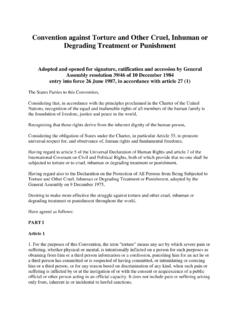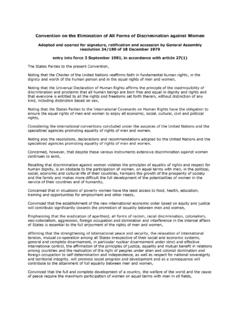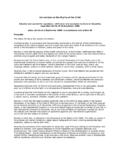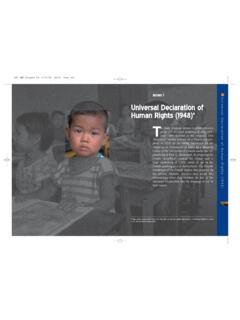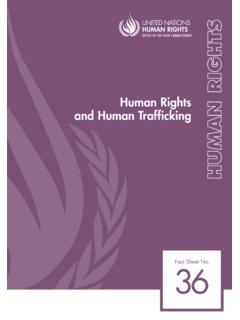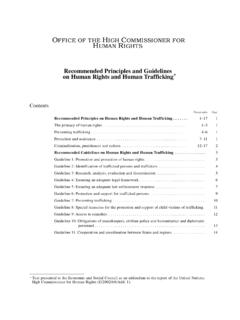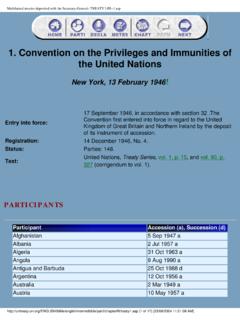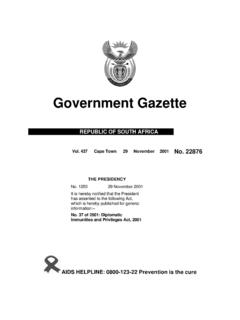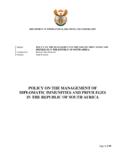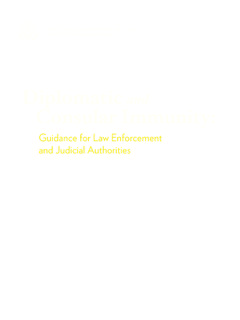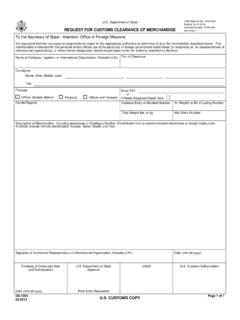Transcription of HANDBOOK FOR HUMAN RIGHTS TREA TY BODY …
1 HANDBOOK . HANDBOOK FOR HUMAN RIGHTS TREATY BODY MEMBERS. FOR. HUMAN RIGHTS . TREATY BODY. MEMBERS. UNITED NATIONS. Designed and Printed at United Nations, Geneva . 1522192 (E) December 2015 2,614 HR/PUB/15/2. HANDBOOK FOR HUMAN RIGHTS . TREATY BODY MEMBERS. New York and Geneva, 2015. NOTE. The designations employed and the presentation of the material in this publication do not imply the expression of any opinion whatsoever on the part of the Secretariat of the United Nations concerning the legal status of any country, territory, city or area, or of its authorities, or concerning the delimitation of its frontiers or boundaries. *. **. Symbols of United Nations documents are composed of capital letters combined with figures. Mention of such a figure indicates a reference to a United Nations document. Cover picture credits: Catalin Petolea/Shutterstock; UN Photo/Albert Gonz lez Farran; Auremar/Fotolia; Alexandre Rotenberg/.
2 Shutterstock; UN Photo/Marco Dormino; XiXinXing/Shutterstock; Eric Crama/Shutterstock; UN Photo/Rick Bajornas; UN Photo/. Evan Schneider; UN Photo/Martine Perret; Paul Prescott/Shutterstock; Paul McKinnon/Shutterstock; Iakov Filimonov/Shutterstock;. and UN Photo/Olivier Chassot. HR/PUB/15/2. 2015 United Nations All worldwide RIGHTS reserved iii FOREWORD. The United Nations HUMAN RIGHTS treaty bodies are at the heart of the HUMAN RIGHTS protection architecture. Their independence, legal analysis of treaty provisions and expert review of implementation by States parties allow them to play a crucial role in promoting and protecting HUMAN RIGHTS around the world. The recent growth of the system, which has doubled in size in the past decade, is testimony to its success, but also has significant implications for the responsibilities of the experts currently 172 elected as members of the 10 treaty bodies.
3 In her report to the General Assembly (A/66/860), my predecessor, Navi Pillay, made key proposals to strengthen the HUMAN RIGHTS treaty body system, which were adopted by the General Assembly in 2014 in its landmark resolution 68/268. In the spirit of this resolution, it is my pleasure to publish this HANDBOOK on the expectations and implications of serving as a treaty body expert for aspiring, newly elected and currently serving members. The quality, devotion and integrity of treaty body experts sustain the value and impact of the treaty body system; they are prerequisites for its effectiveness. This is why States must give their utmost priority to ensuring that their national process for nominating candidates is fair, transparent, gender-balanced and competitive, and to electing the most qualified and best suited candidates to serve on the HUMAN RIGHTS treaty bodies. My Office is committed to continuing to provide a high standard of support to the treaty bodies and their members, and I sincerely hope that this HANDBOOK will assist States in informing potential candidates for treaty body positions and will help aspiring, new and current treaty body members understand their responsibilities and be successful in their important functions.
4 Zeid Ra'ad Al Hussein United Nations High Commissioner for HUMAN RIGHTS iv CONTENTS. iii List of vi Chapter I. INTRODUCTION AND 1. A. B. The treaty bodies and their C. Relationship among treaty bodies and with other United Nations HUMAN RIGHTS II. NOMINATIONS AND 11. A. B. C. III. INDEPENDENCE AND 28. A. Independence and B. Privileges and C. Standards of conduct ..35. D. Prohibition of discrimination, harassment and abuse ..37. IV. WORKLOAD AND 37. A. Specific roles and B. C. Working with D. Media V. PRACTICAL 49. A. B. During the C. D. Financial E. v Annexes I. Guidelines on the independence and impartiality of members of the HUMAN RIGHTS treaty bodies ( the Addis Ababa guidelines ).. 55. II. Administrative arrangements for experts: Note by the Secretariat*.. 60. III. R. egulations Governing the Status, Basic RIGHTS and Duties of Officials other than Secretariat Officials, and Experts on 70.
5 IV. G. uidelines on country visits endorsed by the High Commissioner for HUMAN RIGHTS : Note on visits of treaty body experts to reporting 87. vi LIST OF ABBREVIATIONS. CSO civil society organization DSA daily subsistence allowance HRTD HUMAN RIGHTS Treaties Division NGO non-governmental organization NHRI national HUMAN RIGHTS institution OHCHR Office of the United Nations High Commissioner for HUMAN RIGHTS 1. I. INTRODUCTION AND FUNCTIONS. A. Introduction Being a HUMAN RIGHTS treaty body member is highly rewarding. The treaties and the work of the treaty bodies underpin the international HUMAN RIGHTS system. A treaty body member is at the centre of the interpretation and application of international HUMAN RIGHTS treaty law, and contributes to the promotion, protection and implementation of HUMAN RIGHTS at the national level. Through the review of State party reports, treaty body members assist States in the implementation of treaty provisions, which helps to improve the overall HUMAN RIGHTS situation nationally and across the globe.
6 Inquiries and country visits, as well as the examination of petitions from individuals, help to resolve disputes over HUMAN RIGHTS questions and promote victims' right to a remedy, in turn strengthening the rule of law nationally. Moreover, the formulation of general comments clarifies the meaning of particular provisions and themes related to treaties. General comments have proved invaluable to courts, HUMAN RIGHTS practitioners, national policymakers and many others. Being a treaty body member is also a significant commitment. A treaty body member attends treaty body sessions for 3 to 12 weeks a year and has responsibilities at other times, including, if mandated, preparing and undertaking country visits. All potential candidates for nomination need the necessary expertise and should be aware of the expectations placed on members, including with regard to workload. For these reasons, the High Commissioner for HUMAN RIGHTS recommended, in her 2012 report to the General Assembly on strengthening the treaty body system, the preparation of a HANDBOOK on the workload and expectations for treaty body This HANDBOOK responds to this recommendation.
7 It is primarily designed as a basic guide for candidates as well as current treaty body members. It is also intended to help States parties, national HUMAN RIGHTS institutions (NHRIs) and civil society to understand the role and responsibilities of treaty body members. This chapter therefore provides some background information on the treaty bodies and their responsibilities. Chapter II sets out the process for becoming a treaty body member and provides information on nominations and elections. It also includes an example of good practice that demonstrates a transparent national nomination process. Chapters III, IV and V explain the roles and responsibilities of treaty body members. Chapter III discusses their independence and accountability. It sets out guidelines on independence and impartiality, and identifies some practical challenges facing 1. United Nations reform: measures and proposals (A/66/860), sect.
8 2. treaty body members. It also provides information on the privileges and immunities that they enjoy as well as the standards of conduct expected of them while performing their duties. The chapter then refers to the prohibition of discrimination, harassment and abuse. Chapter IV provides details of the workload that a treaty body member should expect. Chapter V sets out some practical details relating to travel and administration which all treaty body members need to be aware of to ensure the smooth running of a B. The treaty bodies and their procedures The international HUMAN RIGHTS treaty system comprises nine core treaties. Committees of independent experts have been established to review treaty implementation by States that have ratified or acceded to these treaties ( States parties ).3 A tenth treaty, the Optional Protocol to the Convention against Torture, establishes the Subcommittee on Prevention of Torture, with a specific mandate to visit States parties with a view to preventing torture.
9 Each treaty body has the authority to undertake a range of activities to review and support treaty implementation. Not all treaty bodies have the same procedures, however (see also table 2): Reporting procedure. States have obligations under the nine core treaties as well as under the first two Optional Protocols to the Convention on the RIGHTS of the Child4 to submit reports on the measures they have adopted to give effect to the RIGHTS recognized in the treaties as well as on progress made in the enjoyment of those RIGHTS . Treaty bodies review these reports, usually in a dialogue with a delegation from the State party, identifying issues of concern and making related recommendations. Treaty bodies compile these issues and recommendations in what are known as concluding observations. All treaty bodies have adopted the practice of receiving written and oral submissions from non-governmental organizations (NGOs), NHRIs and United Nations entities to help in their review of State party reports.
10 Figure I sets out the reporting cycle for most treaty bodies. 2. ee also the OHCHR glossary of related terms, available from S. (accessed 5 August 2015). 3. The treaties establish all but one of these committees. The Committee on Economic, Social and Cultural RIGHTS was established by Economic and Social Council resolution 1985/17 of 28 May 1985 to carry out the monitoring functions assigned to the Council in Part IV of the International Covenant on Economic, Social and Cultural RIGHTS .. 4. Optional Protocol on the Sale of Children, Child Prostitution and Child Pornography; and Optional Protocol on the . Involvement of Children in Armed Conflict. 3. Table 1: List of treaties establishing treaty bodies Treaty Treaty body International Convention on the Elimination Committee on the Elimination of All Forms of Racial Discrimination (1965) of Racial Discrimination International Covenant on Civil and Political HUMAN RIGHTS Committee RIGHTS (1966).
